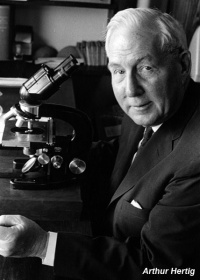Paper - On a normal human ovum not over 7.5 days of age (1945)
| Embryology - 19 Apr 2024 |
|---|
| Google Translate - select your language from the list shown below (this will open a new external page) |
|
العربية | català | 中文 | 中國傳統的 | français | Deutsche | עִברִית | हिंदी | bahasa Indonesia | italiano | 日本語 | 한국어 | မြန်မာ | Pilipino | Polskie | português | ਪੰਜਾਬੀ ਦੇ | Română | русский | Español | Swahili | Svensk | ไทย | Türkçe | اردو | ייִדיש | Tiếng Việt These external translations are automated and may not be accurate. (More? About Translations) |
Hertig AT. and Rock J. On a normal human ovum not over 7.5 days of age. (1945) Anat. Rec. 91: 281.
| Historic Disclaimer - information about historic embryology pages |
|---|
| Pages where the terms "Historic" (textbooks, papers, people, recommendations) appear on this site, and sections within pages where this disclaimer appears, indicate that the content and scientific understanding are specific to the time of publication. This means that while some scientific descriptions are still accurate, the terminology and interpretation of the developmental mechanisms reflect the understanding at the time of original publication and those of the preceding periods, these terms, interpretations and recommendations may not reflect our current scientific understanding. (More? Embryology History | Historic Embryology Papers) |
On a Normal Human Ovum not over 7.5 days of Age
Arthur T . Hertig and John Rock
Free Hospital for Women, Brookline, Mass., Departments of Pathology, Obstetrics and Gynecology, Harvard Medical School and Department of Embryology, Carnegie Institution of Washington.
Abstract from the 1945 annual meeting of American Association of Anatomists
The ovum (Carnegie Embryo 8225) was discovered, after partial fixation, in a bicornuate uterus removed surgically on the twenty-second day of the cycle. Its implantation site was anterior, fundal, without vascular reaction, and just to 4he left of the midline (corpus luteum left). It appeared as a slightly raised but flattened, bowl-like object measuring 0.39 mm. in diame- ter, covered by a glistening membrane which partially concealed the eccentrically-situated 0.07 mm embryonic mass.
Microscopically, the endometrium is in the twenty-first day of its cycle with marked stromal edema and active glandular secretion. The chorion measures 0.120 X 0.306 X 0.330 mm; the chorionic cavity 0.030 X 0.200 X 0.228 mm; the embryo 0.036 X 0.078 X 0.090 mm and the amniotic cavity 0.006 X 0.054 X 0.060 mm
The ovum, a two-thirds implanted blastacyst, possesses trophoblast similar to Carnegie 8020 and varies from a thin indifferent blastocyst wall (abembryonic pole) to a thick shell of primitive syncytio- and cytotrophoblast (embryonic pole). Active invasion and phagocytosis of maternal stroma by syncytiotrophoblast is a prominent feature.
The chorionic cavity is distorted and crowded by an eccentrically-placed, bilaminar germ disk. The amniotic cavity is merely an irregular slit between ectoderm and amnion, the latter arising from trophoblast. Mesoblasts, also apparently arising from trophoblast, are present at the embryonic pole but the exocoelomic membrane (Heuser’s) has not appeared.
Cite this page: Hill, M.A. (2024, April 19) Embryology Paper - On a normal human ovum not over 7.5 days of age (1945). Retrieved from https://embryology.med.unsw.edu.au/embryology/index.php/Paper_-_On_a_normal_human_ovum_not_over_7.5_days_of_age_(1945)
- © Dr Mark Hill 2024, UNSW Embryology ISBN: 978 0 7334 2609 4 - UNSW CRICOS Provider Code No. 00098G


